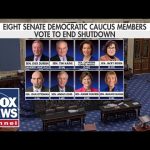Recently, a significant legal battle has unfolded in the realm of economics and governance as the Supreme Court deliberates over President Trump’s authority to impose tariffs. This issue stands at the intersection of law and economics, with implications resonating through markets and affecting the pocketbooks of everyday Americans. The crux of the matter is whether Congress bestowed upon the President enough power to enact these tariffs, stirring debates about the role of the legislative branch versus executive actions.
As the justices weighed in on oral arguments, they posed hard-hitting questions aimed at both the administration and the lawyers challenging the tariffs. This dynamic highlighted a pivotal issue for many business leaders and economists: clarity in the use of laws governing tariffs. The Supreme Court’s inquiries sought to pinpoint the legal basis for the President’s tariff actions, which could have far-reaching consequences for how tariffs are implemented in the future.
If the Court finds that the President relied on the wrong statute, it raises a whole new can of worms. Just imagine the chaos! Businesses could be forced to return funds collected under the tariffs, creating uncertainty in the market—a nightmare scenario for many. It would lead to a messy process of figuring out who gets what back, and who would want to tackle that puzzle? Businessmen and women prefer stable ground they can build upon, not a turbulent sea of legal complications.
On the bright side, business leaders seem to be yearning for one thing above all: certainty. If the Court gives the green light to the tariffs as imposed, there’s room for planning. Business owners would finally know how to price their goods, make future imports, and generally navigate their operations for months and years ahead. That clarity could invigorate the economy, leading to better customer pricing and a more robust market. Nobody likes surprises when it comes to tariffs; they want to know what they’re up against.
Moreover, some justices appear to hold favorable views concerning tariffs as a tool of economic and foreign policy. This suggests that even if the ruling does not favor the administration, the discussion around tariffs might shift focus back to Congress. If the judicial ruling establishes that Congress must take more direct action regarding tariffs, it could open the door for further legislative discussions on trade and economic policies. This could, in turn, lead to a more organized and comprehensive approach to tariff implementation and economic strategy.
As the nation anxiously awaits the Supreme Court’s decision, one thing is clear: the ongoing tariff debate highlights the fine balance of power in U.S. governance. Voters have voiced their concerns about the economy, with affordability and prices weighing heavily on their minds. As political leaders navigate this contentious terrain, both businesses and consumers will be watching closely, eager to see what the future holds in tariff policy and economic regulation.




